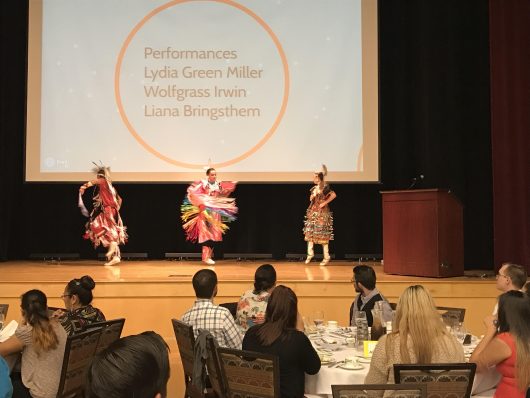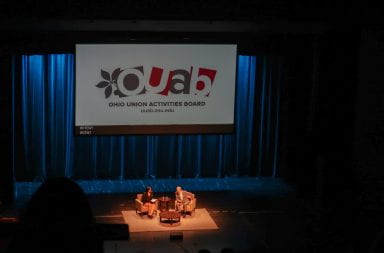
Students attending ‘Alternative Thanksgiving’ enjoy a traditional Native American dance at the 8th annual Alternative Thanksgiving on Nov. 17. Credit: Elizabeth Suarez | Multimedia Editor
Almost 250 people crowded into the Performance Hall at the Ohio Union for the 8th annual Alternative Thanksgiving on Thursday evening, hosted by Ohio State’s Office of Student Life’s Multicultural Center and American Indian Student Initiatives.
While many people will be celebrating Thanksgiving next week, Alternative Thanksgiving holds a significant meaning to those in the Native American community, said Melissa Beard Jacob, intercultural specialist of American Indian and Indigenous Student Initiatives at OSU and member of the Sault Ste. Marie Tribe of Chippewa Indians.
“Alternative Thanksgiving really started out as an alternative way, obviously, to think about the Thanksgiving holiday, and for the Native community and the Native students to come together … and also to educate others about Native culture,” she said.
The event was also an opportunity for the Native community to recognize Native American students for their academic achievements: Five OSU students received scholarships from the Independent Nation of Native Americans Scholarship Fund.
Jacob also announced a milestone for the Native community at OSU.
“This year we have 12 students graduating, which is the largest graduating class of Native students in the history of Ohio State,” Jacob said to those in attendance.
While Thanksgiving is a holiday largely centered around food such as turkey and stuffing, Alternative Thanksgiving featured a meal made up of traditional Native American food.
Dishes included frybread; wojapi, a berry sauce that originates from Plains Indian culture; venison stew; white fish and wild rice; succotash, which consists of corn and lima beans; and sassafras tea.
After the meal, three dancers from various Native American tribes took the stage to perform traditional dances.
One of the performers, Lydia Green Miller, is from the Mackinac Band of the Ojibwe Tribe in Northern Michigan and performed a “fancy shawl dance,” which she has been dancing since she was a child.
“It’s supposed to look like a butterfly,” Miller said. “It’s one of the newer styles of dancing because in the old days the women were very old fashioned, they didn’t have a flashy, fancy kind of dancing, and the men did. So they created this dance as a butterfly to have the women have their own type of fancy, flashy style of dance.”
After the formal performance was over, the dancers left the stage and invited the audience to take part in several traditional dances where almost all in attendance joined in dancing.
The dancers first led the crowd in a “round dance,” which as the name references, is performed in a circle and is also known as a friendship dance.
“The reason why we were holding hands and we were all moving the same way is because we are all connected as a circle, as a life — all races, all ages, no matter what gender you are, anything,” said Miller. “ We are all together, we are all connected together as a friendship, or a family.”


